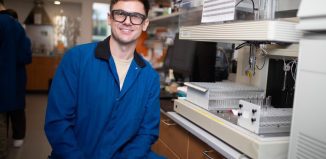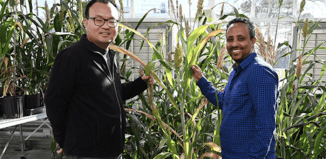Alea Mills studies genes to understand autism
Cold Spring Harbor scientist’s discoveries also focus on cancer treatment
One Sunday in the fall of 2010, Alea Mills needed a break from one of her more mundane jobs — writing proposals to get money. She decided to check on her mice.
When she did, she couldn’t contain her excitement. She’d worked with mice for years and yet these were clearly different. She called her husband Ross Maddalena, an actor who doesn’t particularly enjoy visits to her lab — especially during a football Sunday.
“Please, please, please,” she begged. “You have to come. I need somebody else to observe this.”
Maddalena, an extra in movies like “Mr. Popper’s Penguins” and “Salt” who has taken cues from his wife’s career as he followed her from California to Texas to Long Island, drove to her lab at Cold Spring Harbor, where she has conducted research since 2001.
Even without any scientific expertise, Maddalena recognized the changes. Mills had created a mouse model for autism. Using a hand-held video camera, he recorded the mice. Mills said she has watched the movie dozens of times.
A researcher who has made important cancer discoveries, Mills took the unusual step of using her expertise in chromosome engineering — changing the genetic blueprint of an animal — to study autism.
“I saw [autism] as a genetic problem,” Mills said. “We can generate models where we can make the same precise changes as in various diseases.”
By using a form of molecular scissors, Mills took out a 27-gene region on chromosome 16 in mice.
“We didn’t know what to expect,” Mills recalled. “Could we see anything different with respect to the behavior or the brain anatomy of the mice? The answer is yes. Those genes are regulating fundamental processes that are evolutionarily conserved to some degree and are causing the same type of changes.”
Indeed, these genetically altered mice also showed eight regions in their brains that were larger than normal.
Her results, which were published last October in the prestigious journal Proceedings of the National Academy of Sciences, created a buzz in the world of autism research.
At this point, Mills, who is a resident of Lloyd Harbor, is fine-tuning her autism research to look at even smaller areas within that genetic region. She is also looking more closely at the brains of these mice to see if she can connect some of the more severe behaviors to the biggest changes in brain structures.
While extending this research to understanding the development of autism in humans remains a challenge and will require considerably more work, Mills said this could prove an important step in diagnosis and treatment.
People typically show signs of autism at around 2 or 3 years old, Mills said. In mice, Mills and her postdoctoral research fellow Guy Horev can often detect changes in one to two days after birth.
Researchers like Mills need to figure out the mechanism in which these genes might lead to autism and, once they do, work on a potential clinical model to correct it. Mills cautions that there is considerable work left to do to understand the pathways that lead to autism in humans.
While she will continue to oversee autism research, Mills will also direct and conduct studies on cancer, where she discovered Chd5 and p63. Scientists had long sought Chd5, a gene that produces a protein that prevents cancer. Indeed, the amount of Chd5 protein a patient has is a predictor of treatment outcome for cancer patients. The p63 gene, meanwhile, produces some proteins that suppress cancer, while it manufactures others that promote it. The effect of p63 depends on the type of cell.
Perhaps Mills’ upbringing on a 60-acre piece of property in upstate New York made her comfortable looking out to the horizon for answers to a wide range of questions. The only girl in a family of five children, she said she and her siblings “ran rampant.”
At the same time, when Mills was as young as 3, her mother often encouraged her to slow down and look closely at a small piece of grass, where she could study a flower or a worm.
Those days of watching worms brought her to Cold Spring Harbor, where she witnessed the excitement of her own breakthrough with the first mouse model of autism one Sunday in 2010.






